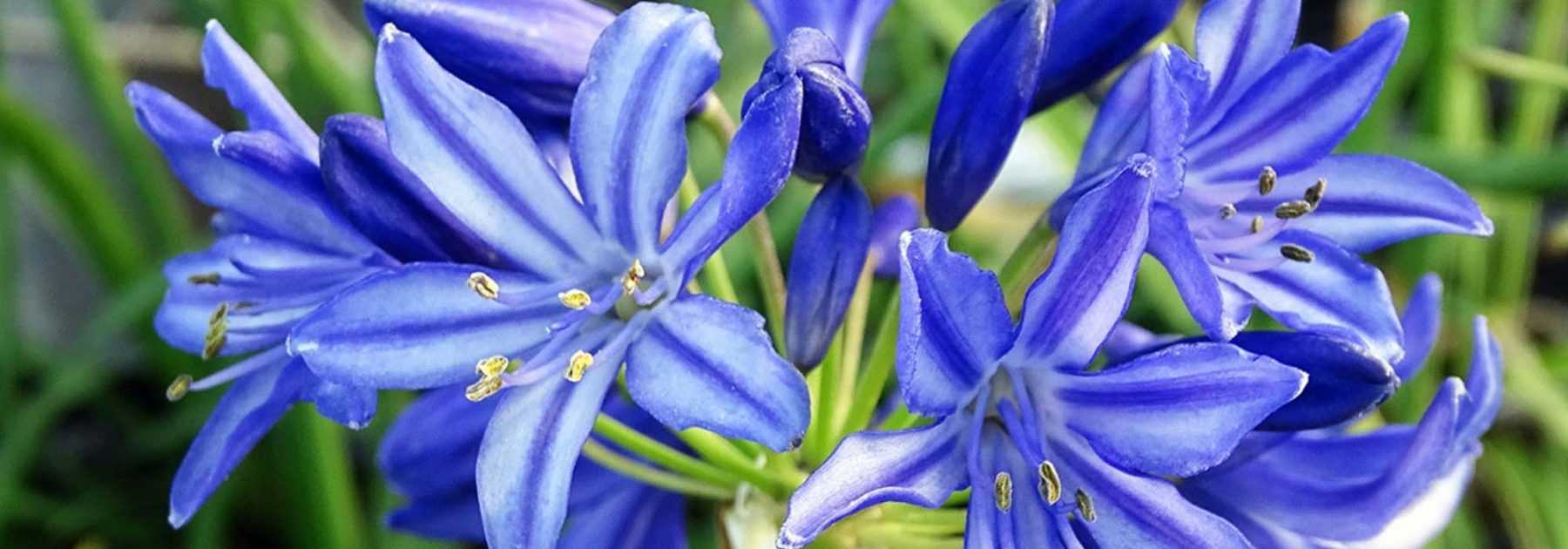
Agapanthus: Planting, Growing and Caring
Contents
Agapanthus in a nutshell
- Agapanthus produce graceful blue flowers that adorn gardens throughout the summer.
- Graphic and dynamic in a garden, they offer colourful vertical accents to decorate borders or flower beds with lightness.
- Agapanthus flowers come in a fabulous range of blues, purples and whites.
- From the most hardy to the less hardy, new varieties of agapanthus can be grown almost anywhere in France.
- Agapanthus are ideal for dry, sunny gardens.
Our expert's word
Agapanthus, these fabulous blue flowers charm us all. They are among the trending plants for landscapers! Loved by professionals, they also appeal to amateur gardeners. I’ve lost count of how many times I’ve been asked to identify a stunning blue flower growing in Brittany. Every time, it was an agapanthus!
Graceful with their light, upright flower spikes, agapanthus are prized for their blueish, purple or white hues. In dry, sunny soil, they create colourful vertical dynamism.
Easy to pair, they harmonise equally well with mineral or plant elements. They’re perfect for contemporary gardens, minimalist gardens, dry gardens or even more natural gardens. You’ll be charmed by their combination with bushes pruned into spheres or their use on urban terraces.
Today their varied shades allow them to complement any colour scheme, and crucially, you can grow them anywhere. Indeed, regions north of the Loire are no longer disadvantaged – varieties like Donau are among the hardiest, tolerating temperatures down to -15°C. Agapanthus are no longer restricted to Mediterranean or coastal climates. However, the soil must be well-draining.
Easy to grow, agapanthus simply require summer watering and winter protection.
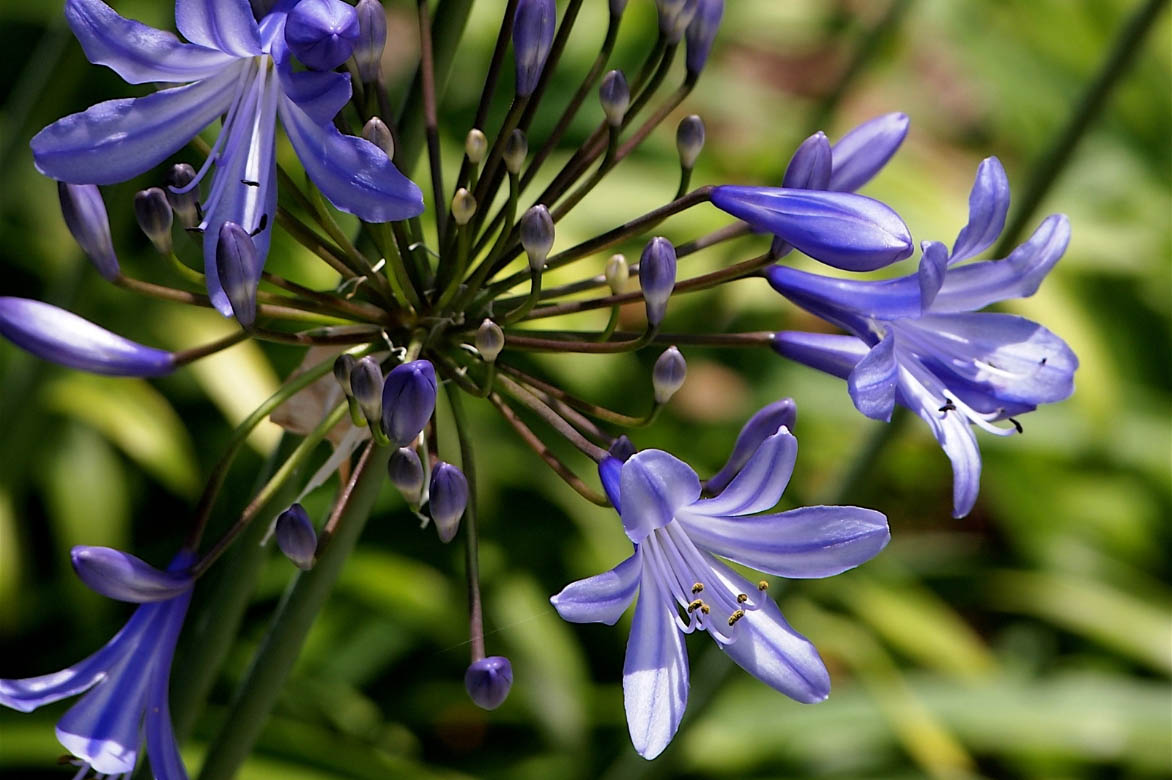
The blue-violet flowers of agapanthus
Description and botany
Botanical data
- Latin name Agapanthus sp.
- Family Alliaceae - Liliaceae
- Common name African lily, Lily of the Nile, Blue tuberose
- Flowering from May to September depending on species and climate
- Height 0.30 to 1.50 metres
- Exposure full sun or sometimes partial shade
- Soil type light, rich and well-drained. All pH levels depending on variety.
- Hardiness -5°C to -15°C
Agapanthus are rhizomatous perennials native to South Africa, also called Lily of the Nile, African lily or Blue tuberose. Growing naturally on rocky or sandy slopes in the Cape Province, they were discovered in South Africa by a Dutchman in the 17th century. Today, the genus Agapanthus comprises about ten different species. The genus name agapanthus comes from the combination of the Greek words agapê meaning ‘love’ and anthos meaning ‘flowers’. Thus, agapanthus very poetically means ‘flower of love’. Highly honoured by Greek philosophers, the term Agapê represents for them the highest form of love, comparable to the love of God.
In summer, the flower stems of the Lily of the Nile rise above the foliage to form a single spherical inflorescence in shades of blue, purple or white at their tip. Each mature plant produces between 20 and 30 flower stems in a season. These flower stems reach between 30 cm and 1.5 metres in height. Rigid, they withstand wind. They end in an umbel measuring between 10 and 20 cm in diameter. This umbel is made up of numerous flowers whose shape resembles that of a trumpet opening into a star. Each flower is composed of 6 petals fused at the base then opening and differentiating from each other. They are usually marked with a darker stripe in the centre. The flowers come in a colour palette ranging from blue, sky blue, blue-grey, blue-violet, violet and even white.
The foliage consists of green, strap-shaped leaves 15 cm to 35 cm long. They are grouped in compact clumps 20 to 50 cm in diameter. The leaves are deciduous or evergreen depending on the species and variety. Deciduous species have the advantage of being more cold-resistant than evergreen species.

Agapanthus flowers come in many colours: white (Albus), lavender blue (Lavander Haze), sky blue, royal blue (Northern star), navy, violet-blue, almost black violet (Black Magic).
Agapanthus thrive in all warm, sunny climates but their cold resistance depends on each variety. Thus, within the agapanthus genus, there are less hardy varieties that cannot tolerate temperatures below -5°C. These are usually evergreen. They are mainly suitable for coastal or Mediterranean regions where temperatures do not drop below -5°C. Agapanthus have even become emblematic plants of the Breton coast. They require container cultivation in regions with cold winters.
The other group within the agapanthus genus are deciduous varieties that can withstand temperatures as low as -10° to -15°C. More hardy, they can be grown almost anywhere in France provided they have good winter protection. Mountainous regions should still be avoided. This cold resistance comes in particular from new agapanthus varieties obtained such as Navy Blue. They delight cooler regions.
Easy to grow, these blue tuberoses are simple to cultivate if your location is well chosen. They dislike being moved. They need sun and warmth to flower. Summer watering is essential to see them flower while winter protection is indispensable in winter in cool and cold regions.
Agapanthus can be used equally well for flowering beds or borders. They are hugely successful in contemporary gardens, dry gardens and even exotic gardens.
Agapanthus can also be used as cut flowers.
The main species and varieties of Agapanthus
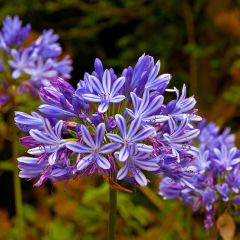
Agapanthus umbellatus
- Flowering time August to October
- Height at maturity 1 m
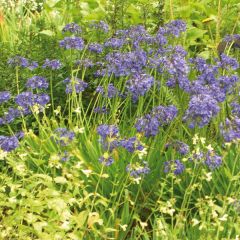
Agapanthus Headbourne Blue
- Flowering time August, September
- Height at maturity 80 cm
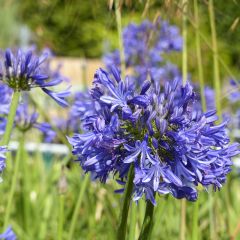
Agapanthus Navy Blue
- Flowering time August, September
- Height at maturity 60 cm
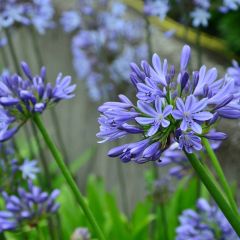
Agapanthus Blue Giant
- Flowering time August, September
- Height at maturity 1,50 m
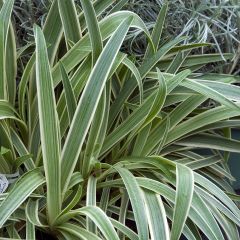
Agapanthus Tinkerbell
- Flowering time August, September
- Height at maturity 60 cm
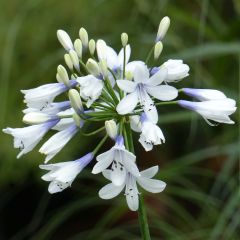
Agapanthus Twister
- Flowering time August, September
- Height at maturity 60 cm
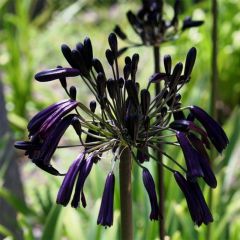
Agapanthus inapertus subsp. pendulus Black Magic
- Flowering time August, September
- Height at maturity 80 cm
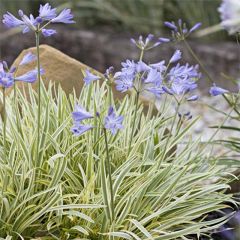
Agapanthus Golden Drop
- Flowering time July to September
- Height at maturity 40 cm
Also discover all our white agapanthus.
Discover other Agapanthus - Lily of the Nile
View all →Available in 1 sizes
Available in 1 sizes
Available in 2 sizes
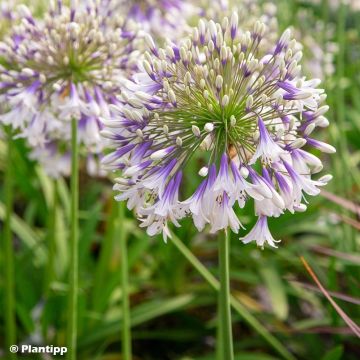
Available in 2 sizes
Available in 2 sizes
Available in 1 sizes
Available in 3 sizes
Available in 5 sizes
Available in 2 sizes
Available in 1 sizes
Planting Agapanthus
When to Plant Agapanthus?
To optimise growth and flowering, the ideal time to plant agapanthus is in spring. This key period gives the plants enough time to establish strong roots before winter temperatures arrive.
Where to Plant Agapanthus?
Location is crucial for successful agapanthus cultivation. These sun-loving plants thrive in warm conditions. While some varieties can adapt to partial shade, they flower more abundantly in direct sunlight. Avoid planting them under dense tree cover, where shade may be too heavy for these light-loving plants.
Soil type also plays a decisive role. Agapanthus prefer well-drained, fertile, and light soil. Good drainage is essential to help them withstand cold periods. Sloped locations, such as banks or natural elevations, are ideal to prevent waterlogging.
Though resistant to wind and sea spray, it’s wise to protect agapanthus from strong winds that could damage their slender flowers. Their tolerance to coastal conditions makes them perfect for seaside gardens.
Agapanthus suit various garden styles, from dry and Mediterranean gardens to contemporary, exotic, or even urban terrace settings. Their dense foliage and spectacular inflorescences make them ideal for borders, pots, or mass plantings. For small spaces or borders, dwarf agapanthus varieties are particularly recommended, combining beauty and adaptability.

Dwarf agapanthus varieties are ideal for pots: Pitchoune Blue, Double Diamond, and Golden Drop.
How to Plant Agapanthus?
Agapanthus prefer to stay in place once planted, so careful site selection is essential. Whether planting in the ground or in pots, each method has advantages, especially for protecting less hardy varieties from cold.
Steps for planting in the ground:
- Preparing the hole: Dig a hole three times the size of the root ball.
- Soil amendment: Prepare a mix of one-third garden soil, one-third compost or potting soil, and one-third sand for optimal drainage. For heavy soils, use a 50% potting soil and 50% sand mix.
- Clearing: Remove weeds and stones from the hole.
- Spacing: Space plants about 50 cm apart, equating to 3–5 plants per square metre, depending on their mature size.
- Planting: For bare-root plants, bury the stump 5–10 cm deep. For potted plants, ensure the root ball is level with the soil.
- Finishing: Backfill with your soil mix, firm well, and water generously.
For in-ground agapanthus, regular watering is crucial, especially in the first few years and during summer, to encourage strong establishment and abundant flowering after 3–4 years.
For container cultivation:
- Pot selection: Choose a pot slightly larger than the root ball or rootstock. Agapanthus thrive when slightly root-bound.
- Drainage: Add a layer of clay pebbles at the base to prevent waterlogging.
- Planting mix: Use a 50% potting soil and 50% sand blend.
- Planting: Insert the root ball or rootstock into the prepared mix.
Container growing is ideal for compact varieties like Pitchoune Blue. For more tips, see our articles How to Grow Agapanthus in Pots, Best Agapanthus for Pots, and 5 Agapanthus to Grow in Pots. Note that agapanthus are among the plants that prefer snug roots!
In frost-prone areas, planting less hardy agapanthus in pots sunk into garden beds (à la French garden style) is wise. This allows easy removal for winter protection.
For more, see our dedicated blog post on planting agapanthus.
Agapanthus Care
Easy to grow, agapanthus require no pruning and are not susceptible to diseases. Their only possible pests are slugs which may eat the young leaves in spring on deciduous varieties.
Agapanthus prefer rather rich soil. When planted in the ground, fertilisers are not necessary. In pots, apply a slow-release fertiliser rich in potash and phosphorus once a year. Supplement with a liquid fertiliser once a month during spring. Fertilising at this time helps boost your plant’s growth and promotes summer flowering which requires energy.
Agapanthus’ drought resistance mainly applies in winter. In summer, agapanthus need watering 1 to 2 times a week, making sure to let the soil dry out between waterings. This summer watering encourages flowering.
During summer, remove faded flowers as they appear by cutting the flower stem at the base. This prevents the plant from using energy to form seeds and instead uses it to produce new flowers. However, if you wish to propagate your agapanthus by sowing, you’ll need to keep the faded flowers so they can develop into seeds.
When cold weather arrives, do not remove the leaves from your agapanthus. They will dry out naturally at their own pace.
In winter, winter protection is essential for your agapanthus. Depending on your climate and the varieties planted, follow our advice: “How to protect agapanthus for winter?
Once your agapanthus plant is established, it’s advisable to divide it every 4 to 5 years to rejuvenate it and ensure abundant flowering.
Propagating Agapanthus
Dividing Agapanthus
The best propagation technique for agapanthus is division. It should be carried out from March onwards, ideally when there’s no risk of frost. Dividing at this time allows the plant to heal during spring while still dormant, with the rest of the season to establish before winter’s first cold spells.
You’ll need a sufficiently large rootstock to divide. To divide, simply:
- Lift your rootstock from the soil using a garden fork.
- Divide your rootstock with a knife or spade into 3 or 4 sections. Each section must have at least one rootstock, one bud, and one leaf if the variety is evergreen.
- Plant your rootstock as described earlier in the Planting Agapanthus section.
For more details on container cultivation, see our full guide on dividing agapanthus in pots.
Dividing agapanthus not only multiplies your plants but also rejuvenates older clumps.
Sowing Agapanthus
Sowing agapanthus is possible but slower and more challenging than division. It takes around 4 years to see the first flowers from sowing. Additionally, since seeds result from cross-breeding, we can’t predict the future agapanthus’s colours or form in advance.
To sow agapanthus, proceed in spring:
- Use seeds formed during the previous year.
- Sow seeds sparingly in a tray of sowing compost.
- Cover the seeds lightly with compost.
- Place the tray at around 18°C. Water lightly but consistently.
- Three weeks later, transplant your seedlings into buckets. Keep watering moderate.
- Six months later, repot your young plants into larger containers.
Pairing Agapanthus in the Garden
Agapanthus pair particularly well with plants and minerals. This is also why landscape designers adore them. They adapt equally well to contemporary gardens, exotic gardens, dry gardens or natural gardens.
For a contemporary garden, pair agapanthus with stipa, perovskia, miscanthus, ornamental alliums and other bushes pruned into balls like crenate holly. The result is guaranteed!
For colour schemes, consider creating a blue monochrome tableau by pairing them with fescues, nepeta and perovskia. Also match the blue of your agapanthus with your shutters, garden gate or other outdoor furniture. Your garden will be all the more sublime for it.
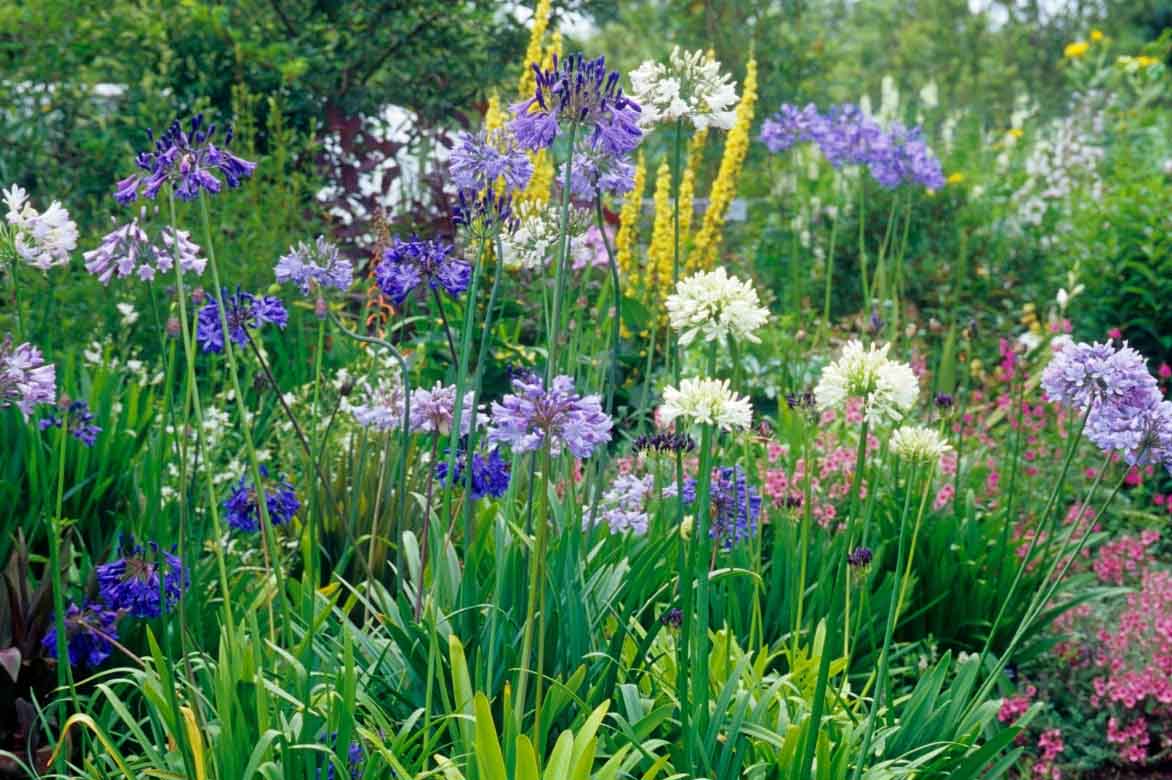
Or play with complementary colours to blue-violet:
- Orange: The coppery orange hues of crocosmia, Kniphofias, Cannas and Daylilies look stunning with violet agapanthus like Royal Velvet.
- The anise green foliage of lady’s mantle or Agastache Golden Jubilee.
- Grey and silver pair with the dark green foliage of agapanthus: artemisia, santolina, bear’s ear and common sage.
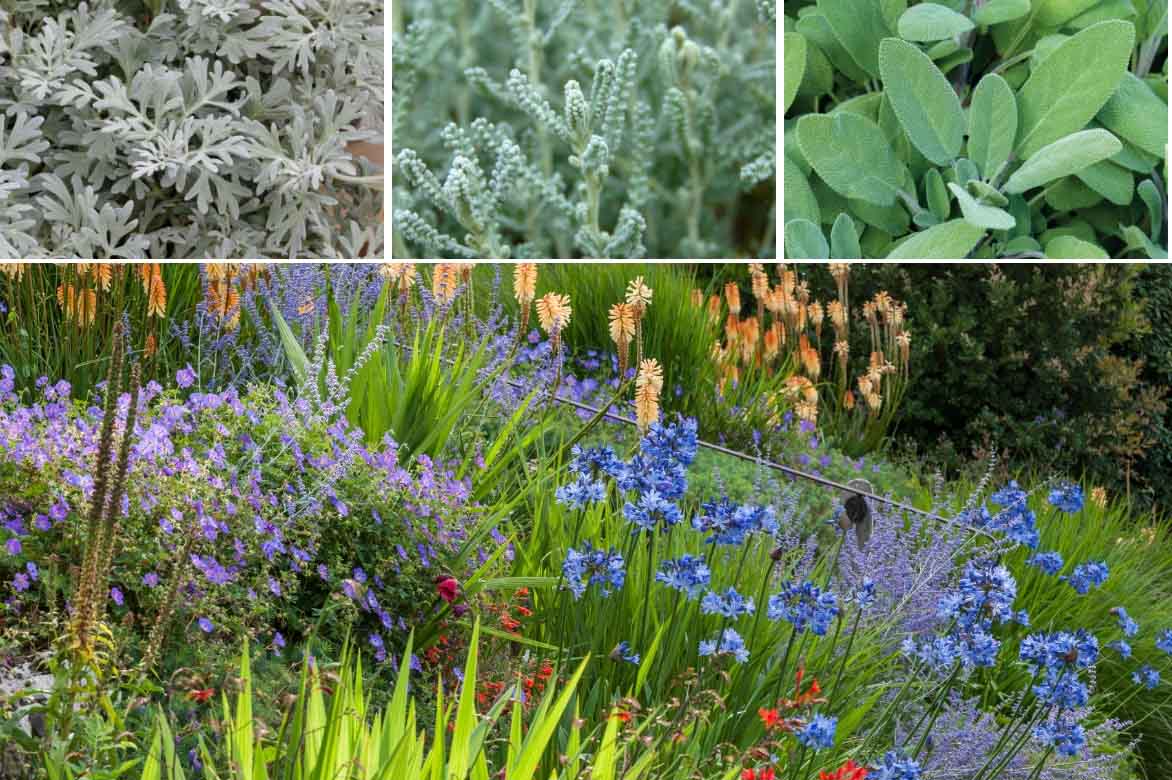
Pair the green foliage of agapanthus with the grey foliage of artemisia, lavender cotton, or sage (Grower’s Friend). The violet flowers of agapanthus complement the orange tones of Crocosmia and Kniphofias.
In an exotic-themed garden, pair agapanthus with cannas, gunnera, phormium or Abyssinian gladiolus.
For a more natural garden, accompany your agapanthus with ornamental grasses, apiaceae (formerly called umbellifers) and gaura.
Useful resources
- In our catalogue, all our Agapanthus varieties
- All our articles about agapanthus: All you need to know about agapanthus
- A contemporary reference garden by Alexandre Thomas: the Agapanthus garden
- 7 White Agapanthus to discover; 7 Blue Agapanthus; Bicolour Agapanthus: 5 must-have varieties; Agapanthus with variegated foliage
- Evergreen Agapanthus
- Agapanthus: the 7 hardiest varieties
- How to grow Agapanthus in pots?; The best dwarf agapanthus to brighten up your garden
- Which agapanthus to plant according to your region?
- What is the best spot to plant an agapanthus?
- Discover “Agapanthus ‘Navy Blue’: a cold-resistant beauty”
- Read Olivier’s article: Are agapanthus endangered?
- Join Gwenaëlle on a tour of Madeira, the island of flowers and discover how to create a garden inspired by Madeira, the island of flowers.
Frequently asked questions
-
The leaves of my agapanthus are turning yellow, what should I do?
There are several reasons why your agapanthus leaves may be turning yellow. In summer, this is likely due to insufficient watering. Indeed, even when planted in the ground, your agapanthus requires watering once or twice a week during the summer months. Simply adjust your watering routine and cut back the yellow leaves to the base. Fresh, green leaves will soon replace them.
However, if you've been diligent with watering and the base of your agapanthus remains damp when you notice the yellowing, the opposite may be true. Excess water can cause leaves to yellow and may lead to root rot. Remove any standing water from saucers if grown in pots, and only water again once the soil is entirely dry.
In autumn, if your agapanthus is deciduous, it’s normal for the foliage to yellow before dropping. Allow the leaves to yellow and dry naturally. Remove them by cutting back to the base when spring returns.
-
My agapanthus are losing their leaves in winter, what should I do?
There are deciduous varieties and evergreen varieties of agapanthus. Your variety is most likely deciduous, so it's perfectly normal for it to lose its leaves in winter.
-
Why are my agapanthus in the ground less beautiful than those in pots?
Agapanthus particularly thrive when grown in containers. They enjoy being quite snug in their pots. With extra care, pot-grown agapanthus can become even more beautiful than those planted directly in the ground. Even when planted in borders, it's essential to water your plants regularly - up to twice weekly during summer.
-
Should I add fertiliser to my agapanthus?
In the ground, agapanthus do not require fertiliser unless your soil is poor. In that case, apply compost to the surface in spring. In pots, fertiliser is essential. Apply a slow-release fertiliser rich in potash and phosphorus in spring. Then, add liquid fertiliser monthly throughout spring and summer.
-
Why are my agapanthus not flowering?
If your agapanthus are not flowering, several factors could be at play. Firstly, they need to be sufficiently mature (at least 4 years old) and well-established (3 years after planting). Secondly, watering must be consistent, especially in summer. During summer, two waterings per week are necessary for good flowering. In pots, a slow-release fertiliser is essential in spring. If they still fail to flower, it's likely due to insufficient sunlight and/or warmth.
-
How to prune agapanthus?
Agapanthus do not require pruning. Simply remove faded flowers as they appear by cutting the stems back to ground level.
- Subscribe!
- Contents
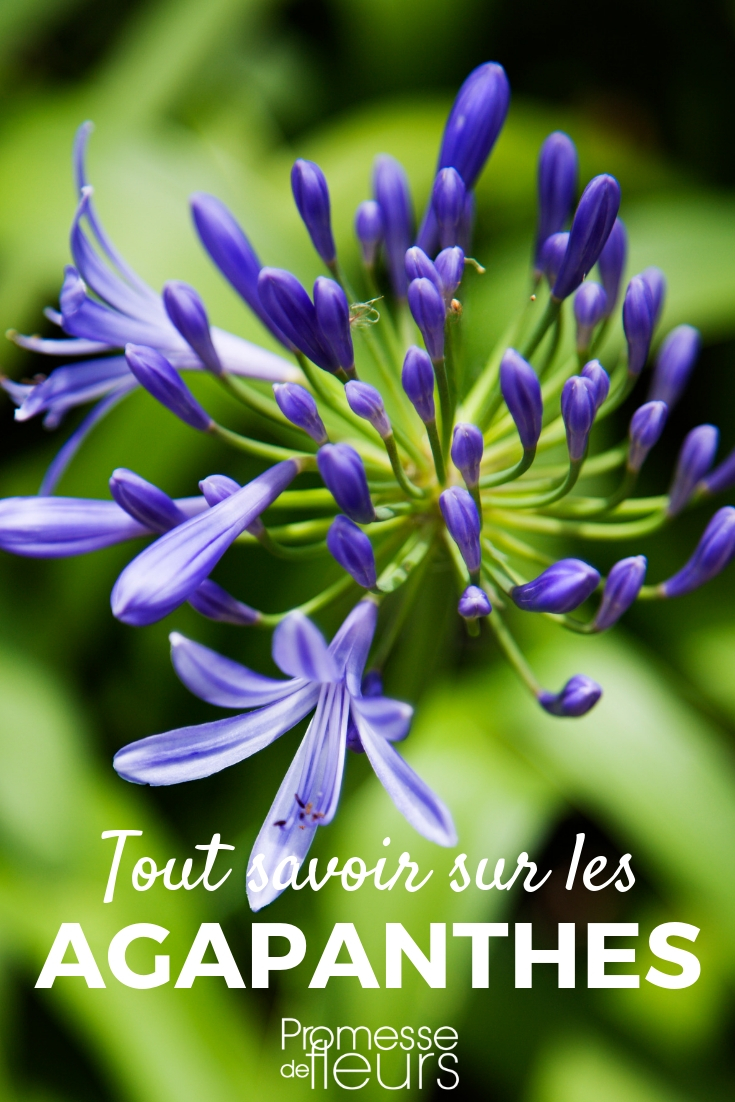


































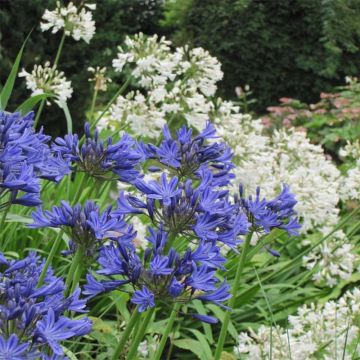
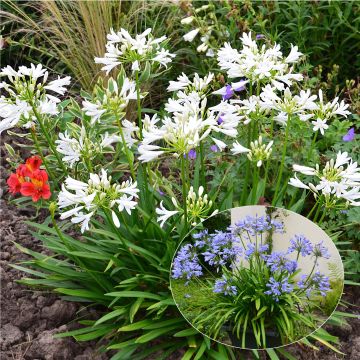
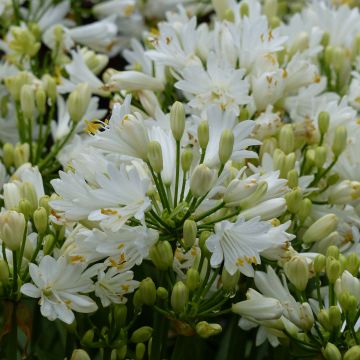
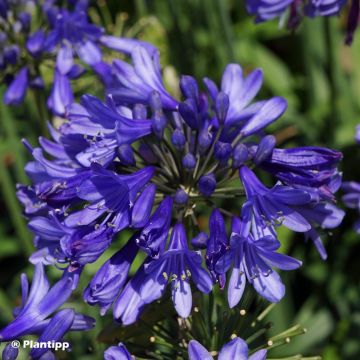
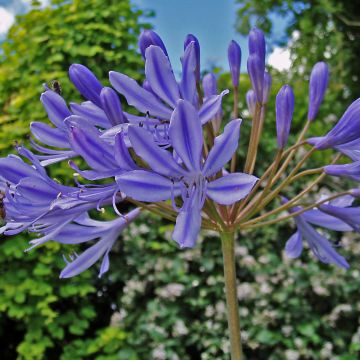


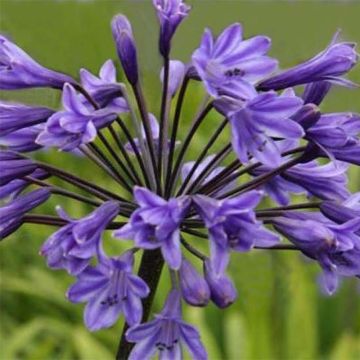
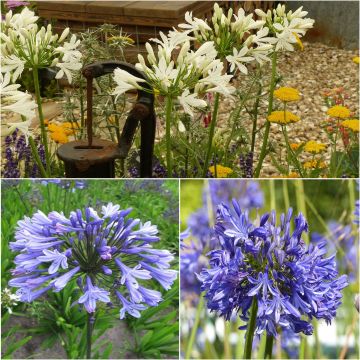
Comments